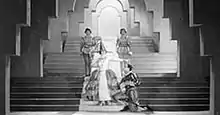The Green Manuela
The Green Manuela (German: Die grüne Manuela) is a 1923 German silent drama film directed by Ewald André Dupont and starring Lucie Labass, Josef Winter and Grete Berger. The film is based on a novel by Clara Ratzka. A gypsy dancer becomes involved with some smugglers in Spain. The film's plot bears a number of similarities to Carmen.[1] It was the first time Dupont worked with the cinematographer Werner Brandes and the art director Alfred Junge who were to become important collaborators with him.[2] The poster of this movie is seen in Russian director Dziga Vertov's movie Man with a Movie Camera (1929) playing at a theater named the Proletarian. It's a symbol of Vertov's disdain of Western fanciful films.
| The Green Manuela | |
|---|---|
 | |
| Directed by | Ewald André Dupont |
| Produced by | Hanns Lippmann |
| Written by | Clara Ratzka (novel) Fritz Podehl Imre Frey |
| Starring | Lucie Labass Josef Winter Grete Berger Angelo Ferrari |
| Cinematography | Werner Brandes Karl Puth |
Production company | |
| Distributed by | UFA |
Release date | 10 October 1923 |
| Country | Germany |
| Language | Silent German intertitles |
Cast
- Lucie Labass as Manuela
- Josef Winter as Carlos Llorrente
- Grete Berger as Frau Gazul
- Kálmán Zátony as Juan Llorrente
- Angelo Ferrari as Count Henri d'Amirón
- Arthur Bergen as Pedro
- Lydia Potechina as Leocadia Barboza
- Louis Ralph as Alfredo
- Geo Bergal as Vincente Delano
- Franz Groß as Old Man Llorrente
- Ari Anzo as Tonia Llorrente
- William Dieterle as Brito
- Giorgio De Giorgetti as Sergeant
References
- Bergfelder & Cargnelli p.28
- Bergfelder & Cargnelli p.28
Bibliography
- Bergfelder, Tim & Cargnelli, Christian. Destination London: German-speaking emigrés and British cinema, 1925-1950. Berghahn Books, 2008.
This article is issued from Wikipedia. The text is licensed under Creative Commons - Attribution - Sharealike. Additional terms may apply for the media files.